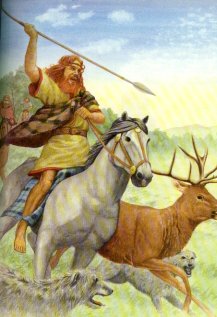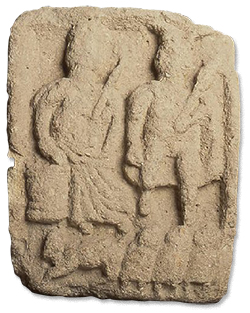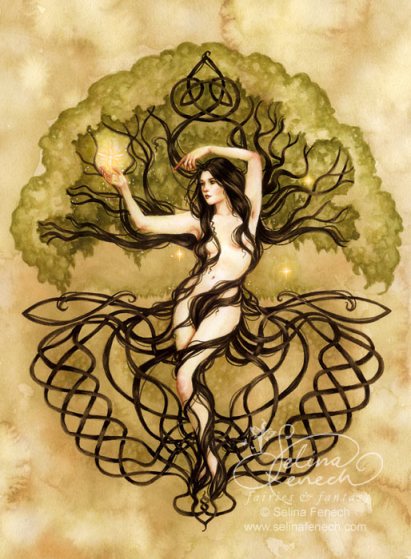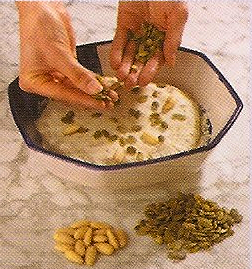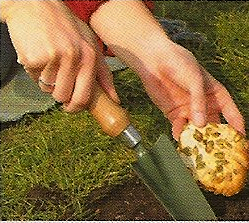
“Demeter” by InertiaK
“Tailtiu’s themes are the first harvest and excelling in a craft or sport. Her symbol is bread. The Irish Goddess Tailtiu was the foster mother of the god of light, Lugh, whom this date venerates. Lugh held Her in such high regard that he created the Tailtean games, which took place during Lammas (rather like the Olympics). This honor may have also had something to do with Tailtiu’s association as an earth Goddess.
In Wiccan tradition, and in many others, today is a day for preparing food from early ripening fruits like apples. it is also a time for baking bread in honor of the harvest. Combining the two, make applesauce bread. Stir the batter clockwise, focusing on any craft or sport in which you wish to excel. As you stir, chant,
‘Flour from grain, the spell begins, let the power rise within; Apples from trees, now impart, Tailtiu, bring _________ to my heart.’
Fill in the blank with a word that describes the area in which you want to encourage improvements or develop mastery. Eat the bread to internalize the energy.
Time-friendly alternatives here are buying frozen bread and adding diced apples to it, having toast with apple butter or just enjoing a piece of bread and apple anytime during the day. Chant the incatation mentally. Then bite with conviction!”
(Patricia Telesco, “365 Goddess: a daily guide to the magic and inspiration of the goddess”.)

“Lughnasadh” by NicoleSamlinski
Patricia Monaghan tells us that Taillte was “the Goddess of August in ancient Ireland [who] was said to be foster mother of the light, embodied in the god Lugh. One of the great Irish earth Goddesses, Taillte lived on the magical Hill of Tara, from which She directed the clearing of an immense forest, the wood of Cuan. It took a month to clear the Plain of Oenach Taillten, where Taillte then built Her palace; it remains on Irish maps today as Teltown, near Kells.
A festival was celebrated annually in Her honor, lasting the whole of August. For generations it was celebrated, complete with mercantile fairs and sporting events; even into the medieval times Taillte’s festivities were held. Eventually, they died out, but in the early part of this century the Tailltean Games – the Irish Olympics – were revived in an attempt to restore Irish culture” (p. 290).
According to a Teltown/Meath tourism site: “The hill of Tailtiu is one of the most celebrated spots in Ireland, for it was here that the celebrated Aonach Tailteann, the Lughnasa Festival was first held.
Tailtiu was the learned daughter of Mag Mor, a distinguished king of Spain, and married to the last great Fir Bolg king, Eochaid mac Eirc, who named his palace after Her, and She was also the foster-mother of the great hero Lugh Lámfhota. Tailtiu lived in Her palace on Ráth Dubh and She led Her people in the clearing of the forest of County Meath, some of Ireland’s best farmland. But the work of clearing proved so onerous as to break Her heart, in the words of the text.

“Lammas” by Wendy Andrews
Queen Tailtiu took the trouble to select a particular spot in which She wished to be buried. It was located on the side of a hill, covered with dense forest; but because of its sunlit and beautiful situation She had chosen it, and Her husband, in compliance with Her wishes, had it cleared of the timber. It took a host of stalwart men nearly a year to accomplish the task.
In this spot Tailtiu desired Her Leath, or tomb, should be made, Her Cuba, or public lamentations, recited, and Her Nosad, or funeral rites and games, duly celebrated, according to the recognised customs of the country.

On Her deathbed Queen Tailte asked that funeral games be held annually on the cleared ground. King Lugh came from his great palace at Nas (now Naas, in Co. Kildare), and had Tailtiu interred in Her ‘green circle on the distant hills.’ Legend says She was buried in a royal state, with impressive druidical rites, on the side of Caill Cuain (now called Sliabh Caillighe), in what is known now as ‘Cairn T‘.
When summoned by the Ard Righ, or High King, such assemblies were of the greatest national importance, and as such were attended by all the minor kings, chiefs and nobles, as well as by vast multitudes of the people from all parts of the five provinces. Participants came from all parts of Ireland, Scotland, and further afield, making Tailtiu the equal of Tara, Tlachtga, and Uisnech.
As a national institution, the Aonach fulfilled three important public functions in the lives of the people. Its first objective was to: do honour to the illustrious dead; secondly, to promulgate laws; and, finally, to entertain the people. Presiding at the Tailtiu assembly or fair became the prerogative of the king of Tara.

“Medieval Tournament” by C. L. Doughty
Lugh lead the first funeral games at the time of Lughnasa (1 August; Lammastide, now Lammas), which consisted of hurling, athletic, gymnastic and equestrian contests of various kinds, and included running, long-jumping, high-jumping, hurling, quoit-throwing, spear-casting, sword and-shield contests, wrestling, boxing, handball, swimming, horse-racing, chariot-racing, spear or pole jumping, slinging contests, bow-and-arrow exhibitions, and, in fact, every sort of contest exhibiting physical endurance and skill. A universal truce was proclaimed in the High King’s name, and all feuds, fights, quarrels and such-like disturbances were strictly forbidden and severely dealt with; and all known criminals were rigorously excluded from both the games and the assembly.
In addition, there were literary, musical, oratorical, and story-telling competitions; singing and dancing competitions, and tournaments of all kinds. Also, competitions for goldsmiths, jewellers, and artificers in the precious metals; for spinners, weavers and dyers; and the makers of shields and weapons of war. The fair lasted for a fortnight.
(At the hill of Tailte is one of the most celebrated spots in Ireland, for it was here in 1420 BCE the celebrated Aonach Tailteann the Lughnasa Festival was first held.)” [2]

“Tailtiu was the last queen of Her kind, a feminine energy that felt the longing of humanity. When the time is right, She gives birth, delivers the sheaves of wheat, then She dies, a need fulfilled….but soon She will rise again. Over the centuries, with the advent of patriarchy, Divinity began to rise towards the heavens, and Lughnasadh, the feast that was once a funerary fair in honor of Tailtiu, now became a celebration of the Sun God, Lugh.” [2]
Sources:
Meath.ie, “HISTORY & LEGEND ABOUT THE TAILTIU & THE TAILTEANN GAMES (A SNIPPET)“.
Monaghan, Patricia. The New Book of Goddesses and Heroines, “Taillte”.
MXTODIS123. An Inner Journey: The Moon, Mythology, and You, “Tailtiu“.
Suggested Links:
Ancientworlds.net, “Tailtiu and the Tailtian Games“.
Brandon-Evans, Tira. Goddess Alive! Goddess Celebration and Research, Issue No. 18 – Autumn/Winter 2010, “Tailtiu: Harvest Goddess“. (HIGHLY RECOMMEND!)
Shee-eire.com, “Tailtiu“.
Tuathadebrighid.net, “The Story of Tailtiu“.
Wikipedia, “Tailtiu“.
 We are approaching the season of Lughnasadh, also known as Lammas. This is the first of three harvest festivals. This one focuses on what we call the “first fruits”, those fruits, vegetables and grains ripening early in the season. The other two are Mabon and Samhain, one celebrating the harvest of the last crops and the next that of the herd animals sacrificed to feed the tribes.
We are approaching the season of Lughnasadh, also known as Lammas. This is the first of three harvest festivals. This one focuses on what we call the “first fruits”, those fruits, vegetables and grains ripening early in the season. The other two are Mabon and Samhain, one celebrating the harvest of the last crops and the next that of the herd animals sacrificed to feed the tribes. 









